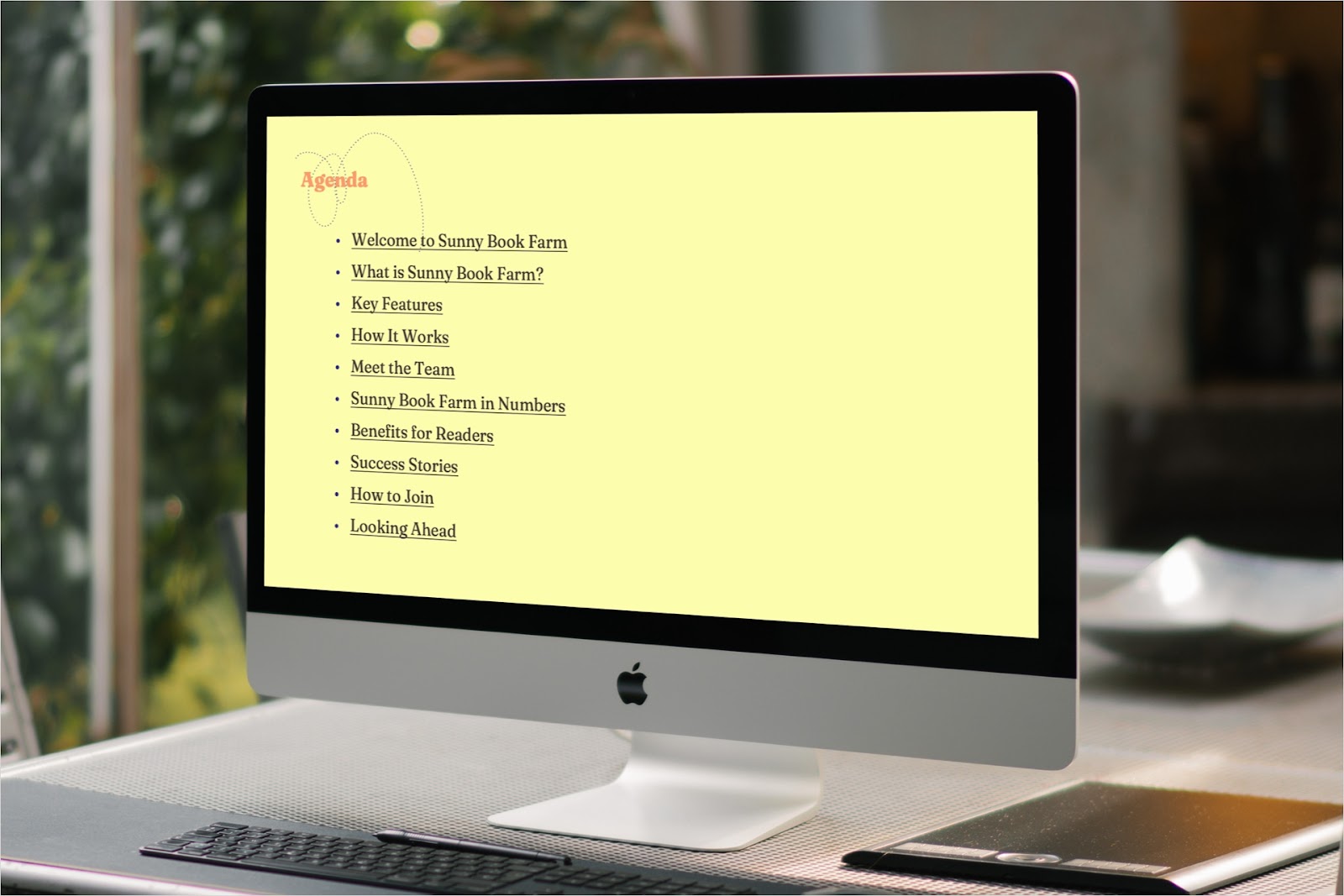A table of contents gives both you and your audience a simple way to see the structure of the impending slideshow. Additionally, by using hyperlinks in your table of contents, you can also navigate to different slides in a PowerPoint presentation quickly.
We’ll show you a super simple option for creating a table of contents in PowerPoint using Plus AI. We’ll then walk through the options you have using PowerPoint features to build the table.
{toc}
Best option: Use the Plus AI “Agenda” slide
The quickest, easiest, and most accurate way to add a table of contents in PowerPoint is by using the Plus AI Agenda slide.
When you create a presentation using Plus AI for PowerPoint, you automatically receive a slide titled Agenda as the second slide. This Agenda includes the titles of all slides that you can use as headings making it easy to turn this slide into a table of contents.

Benefits of this option:
- No outline to access, copy, and paste.
- No manual typing which can easily result in typos.
- All slide titles are automatically included for simple table of contents headings.
- Easily format the Agenda as a bulleted or numbered table of contents list.
- Especially useful for lengthy presentations with many slides because you’ll save a ton of time!
If you go this route, you can jump right down to the Link the Table of Contents section here and skip all of the PowerPoint steps in between!
Alternative option: Insert a table of contents slide and text box in PowerPoint
To use the PowerPoint features for creating a table of contents instead, you’ll begin by adding a new slide with a text box.
Go to the title slide and insert a new slide which comes after it by default. Then, do one of the following:
- Head to the Home or Insert tab, open the New Slide menu, and pick a layout that includes a text box.
- Alternatively, you can use a Blank layout and add a text box by going to the Insert tab, selecting Text Box, and then dragging to draw the box.

Once you have the new slide and text box for the table of contents, you’re ready to add the text. We’ll show you two different methods for inserting the headings (slide titles).
Method 1: Use the outline in PowerPoint
One way to add the slide titles to your table of contents is by using the PowerPoint outline. You can copy the high-level outline and paste those slide titles as headings; however, you must first make sure that each slide has a title.
View and add slide titles
The simplest method for seeing if you have all of your slides titled is to open the Outline View. For any that are missing, you can add them directly in this view.
- Go to the View tab and choose Outline View on the left side of the ribbon.
- Right-click a spot in the outline and choose Collapse All so that you only see the slide titles.

- When the outline displays on the left, you’ll see a numbered multilevel list of your slides. If a slide is missing a title, that number will be blank. For example, you can see below that Slide 3 does not have a title.

- Enter the slide titles for those that are omitted.

The downside to adding slide titles is that you may not want them to display on the slides. But this is an easy fix. Simply drag the title text box off the slide --- you can simply move it up and away from the slide edge out of view.

By doing this, you retain the slide title for your table of contents, but don’t see that title on the slide during the presentation.
Copy and paste the outline
Once you confirm that all slides have titles, you can copy that outline with those titles.
- If you closed the view and expanded the outline, return to View > Outline View and choose Collapse All to show only the slide titles.
- Select all titles in the outline. You can do this easily by using Ctrl + A on Windows or Command + A on Mac. You should then see the outline text highlighted.
- Right-click and choose Copy.

- Go to the table of contents slide, place your cursor inside the text box, go to the Home tab, and pick Keep Text Only or Unformatted Text in the Paste Special menu.

You should then see your slide titles in the text box.

From there, you can format the text and/or the text box per your preference.
Method 2: Insert the text manually in PowerPoint
If you’re not interested in using the outline method or don’t want to add titles to your slides to make that method effective, you can always manually type the text for your table of contents.
- Go to the table of contents slide, place your cursor inside the text box, and type your slide titles or table headings.
- You can press Enter or Return after the headings so that each appears on a separate line.

- Optionally, you can select all text in the box and apply a list style such as Bullets or Numbering in the Paragraph section of the Home tab.

Tip: Check out tips for making PowerPoint slides that look good.
Link the table of contents in PowerPoint
Finally, you can link each heading in the table of contents to the corresponding slide. This makes it a breeze to jump to any slide during the PowerPoint presentation.
- Go to the table of contents slide and select the first heading by dragging through its text.
- Head to the Insert tab or right-click and select Link > Insert Link.

- In the pop-up box, choose Place in This Document on the far left.
- Expand Slide Titles on the right if necessary and select the first slide title for the heading.

- Click OK and you’ll see the heading text linked to the slide.
- Follow the same process for each heading in the table of contents.

When you present your slideshow and arrive at the table of contents, click any heading to move directly to that slide.
Conclusion
By adding a PowerPoint table of contents, you can not only provide the presentation structure but easily skip directly to any slide. This is helpful if you aren’t using Presenter View, are sharing your slideshow, or hand over the playback controls to someone else.
Along with the fastest way to create that table of contents by using Plus AI, this PowerPoint add-on offers a robust feature set for building and editing presentations. Visit the Plus AI website for complete details.
FAQs
How do I create a table of contents in Word?
Unlike PowerPoint, you can insert an automatic table of contents in Microsoft Word. First, make sure that you have the headings formatted as such. Use the Styles menu on the Home tab to set the styles.
Then, go to the References tab, open the Table of Contents menu, and choose a style.
How do I add a table in PowerPoint?
If you want to add a simple table to better structure data in PowerPoint, you can build one easily. Go to the Insert tab, open the Table menu, and choose the size to pop the table right onto the slide.
How do you align a table of contents in PowerPoint?
Because you’re using a text box for the table of contents, you can use the same alignment tools that you would use for any other text box in the slideshow.
To align the text inside the box, select it and choose an alignment in the Paragraph section of the Home tab. To align the box on the slide instead, select it and choose an alignment in Arrange > Align on the Home tab.





